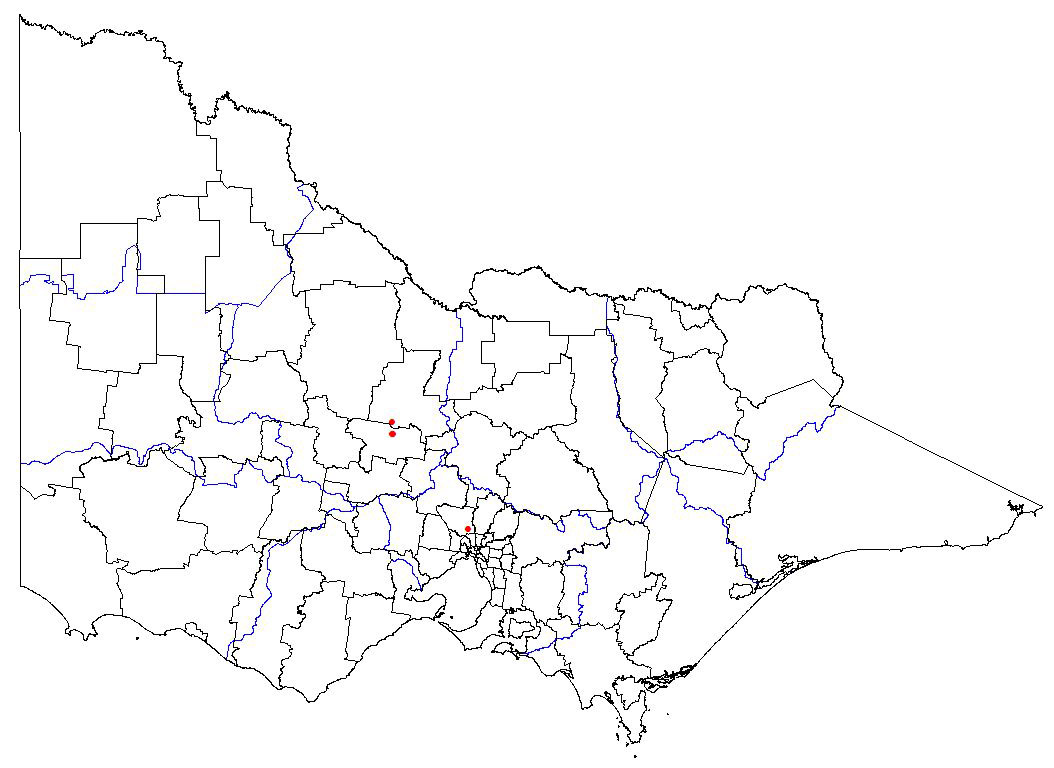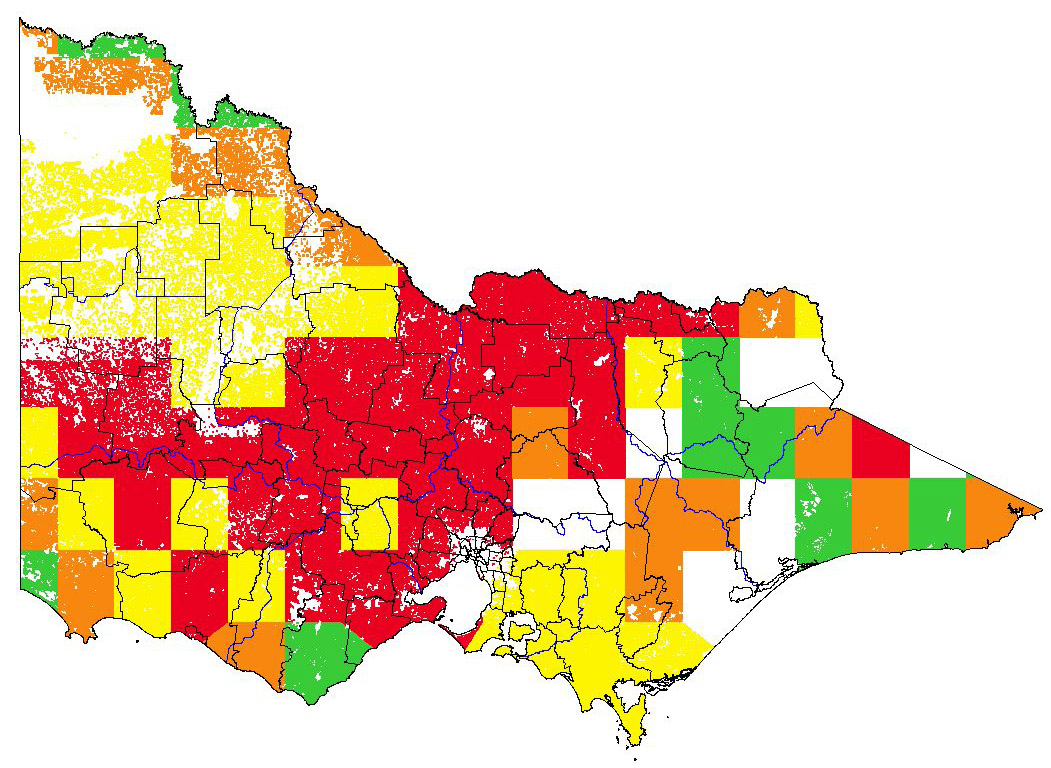Wine cups (Geissorhiza aspera)
Present distribution
|  Map showing the present distribution of this weed. | ||||
| Habitat: “Found mostly on sandy soils, flats, and slopes” (Pacific bulb society 2009). “On flats and slopes between 10-700m. It prefers moist, sandy soils and usually flowers after good winter rains. Geissorhiza aspera requires a dry summer period” (Plantzafrica 2006). “Recorded near water” (Fernkloof Nature Reserve 2009). “One of the more cold-hardy species” (Burnie et al 1997). | |||||
Potential distribution
Potential distribution produced from CLIMATE modelling refined by applying suitable landuse and vegetation type overlays with CMA boundaries
| Map Overlays Used Land Use: Horticulture perennial; horticulture seasonal; pasture dryland; pasture irrigation Ecological Vegetation Divisions Coastal; heathland; grassy/heathy dry forest; lowland forest; foothills forest; forby forest; damp forest; wet forest; rainforest; high altitude shrubland/woodland; alpine treeless; granitic hillslopes; rocky outcrop shrubland; western plains woodland; basalt grassland; alluvial plains grassland; semi-arid woodland; alluvial plains woodland; ironbark/box; riverine woodland/forest Colours indicate possibility of Geissorhiza aspera infesting these areas. In the non-coloured areas the plant is unlikely to establish as the climate, soil or landuse is not presently suitable. | 
|
Impact
QUESTION | COMMENTS | RATING | CONFIDENCE |
| Social | |||
| 1. Restrict human access? | “Small perennial herb with annual leaves and flowers, to 40 cm high” (Richardson et al 2006). “With sword-shaped leaves. This bulbous plant is 100-350 mm high” Leaves are 2-5 mm wide. Inflorescence is 3- to 7-flowered (Plantzafrica 2006). The herbaceous nature of this plant is not likely to restrict human access. | L | M |
| 2. Reduce tourism? | “Small perennial herb with annual leaves and flowers, to 40 cm high” (Richardson et al 2006). “With sword-shaped leaves. This bulbous plant is 100-350 mm high” Leaves are 2-5 mm wide. Inflorescence is 3- to 7-flowered (Plantzafrica 2006). This plant is probably not obvious as a weed to the average visitor no will impact on recreation. | L | ML |
| 3. Injurious to people? | “Small perennial herb with annual leaves and flowers, to 40 cm high” (Richardson et al 2006). “With sword-shaped leaves. This bulbous plant is 100-350 mm high” Leaves are 2-5 mm wide. Inflorescence is 3- to 7-flowered (Plantzafrica 2006). Not described as having prickles, toxic properties or causing allergies. | L | ML |
| 4. Damage to cultural sites? | “Small perennial herb with annual leaves and flowers, to 40 cm high” (Richardson et al 2006). “With sword-shaped leaves. This bulbous plant is 100-350 mm high” Leaves are 2-5 mm wide. Inflorescence is 3- to 7-flowered (Plantzafrica 2006). Little or negligible effect on aesthetics or structure of site. | L | ML |
| Abiotic | |||
| 5. Impact flow? | “Found mostly on sandy soils, flats, and slopes” (Pacific bulb society 2009). “On flats and slopes between 10700 m. It prefers moist, sandy soils and usually flowers after good winter rains. Geissorhiza aspera requires a dry summer period” (Plantzafrica 2006). “Recorded near water” (Fernkloof Nature Reserve 2009). Not known to be aquatic. | L | ML |
| 6. Impact water quality? | “Found mostly on sandy soils, flats, and slopes” (Pacific bulb society 2009). “On flats and slopes between 10700 m. It prefers moist, sandy soils and usually flowers after good winter rains. Geissorhiza aspera requires a dry summer period” (Plantzafrica 2006). “Recorded near water” (Fernkloof Nature Reserve 2009). Not known to be aquatic. | L | ML |
| 7. Increase soil erosion? | “Small perennial herb with annual leaves and flowers, to 40 cm high” (Richardson et al 2006). “Can form carpets in suitable areas” (Fernkloof Nature Reserve 2009). May have potential to cause some erosion after dying down, but low probability of large scale soil movement. | L | ML |
| 8. Reduce biomass? | “Small perennial herb with annual leaves and flowers, to 40 cm high” (Richardson et al 2006). “With sword-shaped leaves. This bulbous plant is 100-350 mm high” Leaves are 2-5 mm wide... Along roadsides and park ground, where it flourishes, due to mowing of grasses and thus reduction in competition plants” (Plantzafrica 2006). As this plant is so small and seemingly only does well where competing plants are mown, it is likely to only be a direct replacement of similar sized species. | ML | L |
| 9. Change fire regime? | |||
| Community Habitat | |||
| 10. Impact on composition (a) high value EVC | “Small perennial herb with annual leaves and flowers, to 40 cm high” (Richardson et al 2006). “With sword-shaped leaves. This bulbous plant is 100-350 mm high” Leaves are 2-5 mm wide. Inflorescence is 3- to 7-flowered (Plantzafrica 2006). As this plant is so small and seemingly only does well where competing plants are mown, it is likely to only cause a small or negligible effect on fire risk. | L | L |
| (b) medium value EVC | EVC = Rocky Outcrop Shrubland (V); CMA =North East; Bioregion =Northern Inland Slopes; VH CLIMATE potential. Minor displacement of some dominant or indicator spp. within any one strata/layer. | ML | H |
| (c) low value EVC | EVC = Box Ironbark Forest (D); CMA =North Central; Bioregion =Goldfields; VH CLIMATE potential. Minor displacement of some dominant or indicator spp. within any one strata/layer. | ML | H |
| 11. Impact on structure? | EVC = Heathy Dry Forest (LC); CMA =Goulburn Broken; Bioregion =Highlands- Northern Fall; VH CLIMATE potential. Minor displacement of some dominant or indicator spp. within any one strata/layer. | ML | H |
| 12. Effect on threatened flora? | “Can form carpets in suitable areas” (Fernkloof Nature Reserve 2009). Minor or negligible effect on 20% of the floral strata/ layers present; usually only affecting one of the strata. | L | L |
| Fauna | No information found. | MH | L |
| 13. Effect on threatened fauna? | No information found. | MH | L |
| 14. Effect on non-threatened fauna? | “Can form carpets in suitable areas” (Fernkloof Nature Reserve 2009). Could cause a minor reduction in habitat/food/habitat. | L | L |
| 15. Benefits fauna? | “Small perennial herb with annual leaves and flowers, to 40 cm high” (Richardson et al 2006). “With sword-shaped leaves. This bulbous plant is 100-350 mm high” Leaves are 2-5 mm wide. Inflorescence is 3- to 7-flowered (Plantzafrica 2006). As this is such a thin stemmed plant, probably provides very little support to desirable species. | H | L |
| 16. Injurious to fauna? | “Small perennial herb with annual leaves and flowers, to 40 cm high” (Richardson et al 2006). “With sword-shaped leaves. This bulbous plant is 100-350 mm high” Leaves are 2-5 mm wide. Inflorescence is 3- to 7-flowered | L | ML |
| Pest Animal | |||
| 17. Food source to pests? | No information found. | M | L |
| 18. Provides harbor? | “Small perennial herb with annual leaves and flowers, to 40 cm high” (Richardson et al 2006). “With sword-shaped leaves. This bulbous plant is 100-350 mm high” Leaves are 2-5 mm wide. Inflorescence is 3- to 7-flowered (Plantzafrica 2006). As this is such a thin stemmed plant, probably provides very little support to pest species. | L | L |
| Agriculture | |||
| 19. Impact yield? | No information found. | M | L |
| 20. Impact quality? | No information found. | M | L |
| 21. Affect land value? | No information found. | M | L |
| 22. Change land use? | No information found. | M | L |
| 23. Increase harvest costs? | No information found. | M | L |
| 24. Disease host/vector? | “Pests of Geissorhiza aspera include thrips and aphids which cause damage to leaves, aphids also transmit viral diseases” (Plantzafrica 2006). Host to common pests. | M | ML |
Invasive
QUESTION | COMMENTS | RATING | CONFIDENCE |
| Establishment | |||
| 1. Germination requirements? | It prefers moist, sandy soils and usually flowers after good winter rains. Geissorhiza aspera requires a dry summer period” (Plantzafrica 2006). Likely to only need seasonal disturbances such as seasonal rainfall. | MH | L |
| 2. Establishment requirements? | “Where it flourishes, due to mowing of grasses and thus reduction in competition plants” (Plantzafrica 2006). Possibly will specifically require more open ground to establish. | ML | ML |
| 3. How much disturbance is required? | “Naturalized in to urban environments…and are found along roadsides and park ground, where it flourishes, due to mowing of grasses and thus reduction in competition plants” (Plantzafrica 2006). Major disturbance required with little, or no, competition from other plant species. | L | ML |
| Growth/Competitive | |||
| 4. Life form? | “Cormous geophyte” (Plantzafrica 2006). | ML | M |
| 5. Allelopathic properties? | No mention of allelopathic properties in information found. | L | L |
| 6. Tolerates herb pressure? | No information found. | M | L |
| 7. Normal growth rate? | No information found. | M | L |
| 8. Stress tolerance to frost, drought, w/logg, sal. etc? | “One of the more cold-hardy species” (Burnie et al 1997). It prefers moist, sandy soils and usually flowers after good winter rains. Geissorhiza aspera requires a dry summer period” (Plantzafrica 2006). May be tolerant to frost. Probably not tolerant to waterlogging and drought. Unknown to fire and salinity. | L | ML |
| Reproduction | |||
| 9. Reproductive system | “Propagation by seed or by offset of corm (Spencer 2005). “Cormous geophyte” (Plantzafrica 2006). Likely to naturally reproduce both vegetatively and sexually. | H | ML |
| 10. Number of propagules produced? | No information found. | M | L |
| 11. Propagule longevity? | No information found. | M | L |
| 12. Reproductive period? | No information found. | M | L |
| 13. Time to reproductive maturity? | No information found. | M | L |
| Dispersal | |||
| 14. Number of mechanisms? | No information found. | M | L |
| 15. How far do they disperse? | No information found. | M | L |
References
Burnie G, Forrester S, Grieg D, Guest S, Harmony M, Hobley S, Hackson G, Lavarack P, Ledgett M, McDonald R, Macoboy S, Molyneux B, Moodie D, Moore J, Newman D, North T, Pienaar K, Purdy G, Silk J, Ryan S, Schien G (1997) Botanica Random House. Milsons Point, NSW.
Fernkloof Nature Reserve (2009) Geissorhiza aspera. Available at: http://fernkloof.com/species.mv?563 (verified 23/03/2009).
Pacific Bulb Society (2009) Geissorhiza Species One. Available at: http://www.pacificbulbsociety.org/pbswiki/index.php/GeissorhizaSpeciesOne (verified 25/03/2009).
Plantzafrica (2006) Geissorhiza aspera Goldblatt. Available at: http://www.plantzafrica.com/plantefg/geissorhizaaspera.htm (verified 23/03/2009).
Richardson FJ, Richardson RG and Shepherd RCH. (2006) Weeds of the South-east. An Identification Guide for Australia. RG & FJ Richardson. Meredith.
Spencer R. (Ed.) (2005) Horticultural Flora of South-Eastern Australia Volume 5. Flowering Plants Monocotyledons. UNSW Press.
Global present distribution data references
Australian National Herbarium (ANH) (2008) Australia’s Virtual Herbarium, Australian National Herbarium, Centre for Plant Diversity and Research, Available at http://www.anbg.gov.au/avh/ (verified 05 May 2009).
Department of the Environment and Heritage (Commonwealth of Australia). (1993 – On-going) Australian Plant Name Index (APNI) http://www.cpbr.gov.au/apni/index.html (verified 07/05/2009).
Department of Sustainability and Environment (DSE) (2006) Flora information system [CD-ROM], Biodiversity and Natural Resources Section, Viridans Pty Ltd, Bentleigh.
Global Biodiversity Information Facility (GBIF) (2008) Global biodiversity information facility, Available at http://www.gbif.org/ (verified 05 May 2009).
Missouri Botanical Gardens (MBG) (2009) w3TROPICOS, Missouri Botanical Gardens Database, Available at http://mobot.mobot.org/W3T/Search/vast.html (viewed 07/05/2009).
Feedback
Do you have additional information about this plant that will improve the quality of the assessment?
If so, we would value your contribution. Click on the link to go to the feedback form.


